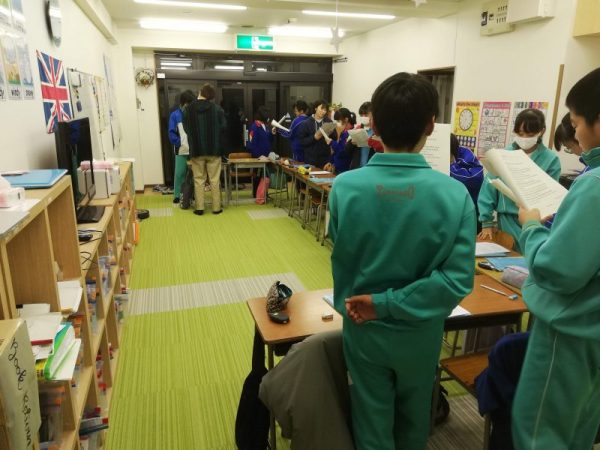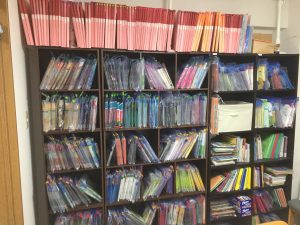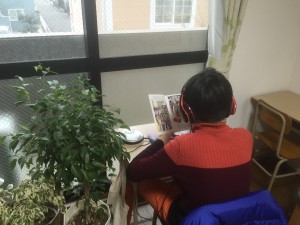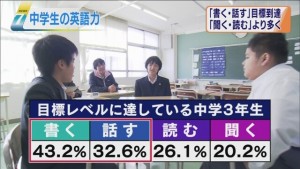Academy business curriculum eikaiwa extensive listening extensive reading goals high school JHS junior high school language courses materials school management textbooks
by sendaiben
1 comment
Cambridge Academy: Year Four and Five

It’s all coming together. Or is it?
You can read previous Academy posts here:
- Extensive Reading for Secondary Students (April 2015)
- Six Months In (September 2015)
- Year One (February 2016)
- Looking at Year Two (March 2016)
- Stocktake (March 2016)
- Shadoku explained (April 2016)
- Some improvements to the curriculum (April 2016)
- December 2016 update (December 2016)
- Cambridge Academy: Year Two and Three (March 2017)
- Cambridge Academy: Stocktake 2017 (March 2017)
- Cambridge Academy: Another Quantum Leap (April 2017)
- Cambridge Academy: Year Three Mid-Year Update (August 2017)
- Cambridge Academy: Year Three Student Progress (October 2017)
- The Academy Fluency Course (March 2018)
- Cambridge Academy: Stocktake 2018 (March 2018)
This year was a solid one for the Academy but we definitely had some ups and downs.
Mistakes were made (by me)
Let’s start with the downs: we screwed up badly not just once but twice. The first mistake was getting a bit cocky about the Academy and changing the way we explained it to existing students.
In the past we’d gone into each class with 6th graders in, introduced the Academy and encouraged them to join. Almost everyone did.
Last year, we asked everyone to come to a special explanation session on a Sunday, then asked them to come in again in January and line up to sign up for the days they wanted. Only about half the students joined.
This is a mistake we’ll be paying for for the next five years, as we have a year that is quite a bit smaller than it should be. Looks like we’ll have 22 second-year students next year, spread over three classes of 4, 6, and 12 students. Doubly regrettable because the Academy classes work much better with at least ten students in.
This year we went back to the original, more humble model and right now halfway through the explanations pretty much all our 6th graders have signed up. If all goes well we should end up with 28 first-graders in three classes.
The second mistake was delegating too much. As planned I assigned a teacher to each class, but then failed to monitor them as closely as I should have (in my defence we had some pretty serious issues crop up this year that took a lot of time at first and then burned me out later).
As a direct consequence of me not paying enough attention to how the classes were going, the current first-year classes in particular are not where I want them to be, and all the reading classes have gone slightly off course.
Nothing too serious, but changes will be needed next year.
But lots of good things happened too
Despite the lack of attention from me, the classes mostly went well and students learned a lot. We did Eiken last month at the school, and 78 out of 82 students passed the paper test. Last weekend we did interview practice, and everyone was basically okay to pass. This is very encouraging, as our student body is very mixed and doesn’t just consist of elite students.
We wrote 2/3 of the A3 output course, and it turned out really well. I’m proud of all our materials, but this might be the best one yet. We also finished one year of the A5 advanced course.
Very few of our students quit. We lost a handful to graduation and three quit, but we’re hoping to have a healthy intake and we also had four students join from outside. Hopefully that is the start of a trend 🙂
Student numbers
Junior high school 1: 28? (still in the process of pitching to parents)
Junior high school 2: 22
Junior high school 3: 30
Senior high school entry class (1-2 year students): 10
Senior high school advanced class (2-3 year students): 11
Pretty encouraging. It will be interesting to see how many of the new JHS 3rd years stay on into high school, as they were our first big year.
Also, the mathematically gifted among you will notice that this would give us 101 students, finally reaching our longstanding goal of 100 students in the Academy. Eventually I am hoping we’ll have something like 200 in the program (see below for how this may be possible).
Future plans
We’re going to rent the third unit on the ground floor of our building. This will give us all the car parking spaces (an additional four) plus get rid of the grumpy guy that used to rent it so no one will be complaining about our students going forwards. This extra unit will give us about 280 new class places and allow us to have all junior high school levels of the Academy, plus one high school level, every weekday.
I’m going to be much more hands on with the reading classes next year, and with the junior high school first year output classes. This will allow me to develop them a bit more and address structural problems (as well as train our teachers).
I’m going to take another leaf out of SEG’s book and try to find supplementary reading material for our beginner levels. At the moment the students read sets of readers with CDs, but I would also like to mix in picture books and other reading material that they might find interesting. A big work in progress.
We’ll finish the A3 course and start working on our final level, A4. We’ll also write a second year of the A5 course. This will complete the Academy materials, at which point we might start working on a course for elementary school students.
Outlook
The outlook is good. I am not going to be able to be as hands-off next year as I was this year, but I think the program will get a lot stronger because of that.
We will be in a position to recruit hundreds of new students next year, including almost 100 new Academy students, so we will need to start working on advertising for April 2020 from now. It’s going to be intense but also kind of fun 🙂
Academy curriculum extensive listening extensive reading high school junior high school school management
by sendaiben
2 comments
Cambridge Academy: Year Two and Three
Takeoff
The Academy appears to be taking off. We have over 30 JHS1 students starting next month, including half a dozen new prospects that found us through word of mouth (some of our students are doing very well in school) or from our new website. Our new fluency-based curriculum is ready for testing. We’ve rented a second reading classroom and are buying a lot of new books.
We haven’t reached 100 students yet (how naive that goal seems now) but we’re getting closer. We should definitely hit it next year if not before.
You can read previous Academy posts here:
- Extensive Reading for Secondary Students (April 2015)
- Six Months In (September 2015)
- Year One (February 2016)
- Looking at Year Two (March 2016)
- Stocktake (March 2016)
- Shadoku explained (April 2016)
- Some improvements to the curriculum (April 2016)
- December 2016 update (December 2016)
More importantly, we have learned a lot over the last few months and should be able to improve class content and avoid operational issues next year.
2016-17 Academic Year
Some highlights from this year:
- shadoku has been a huge success
- our students are starting to make real progress
- we had incredible eiken results this time round
- word of mouth from our success stories seems to be very positive
- students love graduating from guided ER to independent ER
- varied reading materials work very well (particularly comics)
Some lessons learned:
- we had a ‘pre-Academy’ course this year for elementary 6th grade students that just did reading but I am not at all happy with the results so we’ll be discontinuing it
- scheduling was a huge pain this year and some parents got annoyed with us
- our textbook choices were not great -need to tighten up the output class content
2017-18 Academic Year
A few big changes next year. The biggest is that I’ll be teaching all the junior high school classes, both input (reading) and output (communication). I’m doing this because I want to really work on the curriculum and trial our new fluency materials. We will have over fifty JHS students from April.
We’re increasing class sizes. Until now we’ve had output classes of six, but from April we’ll have up to ten students in a class. I think this should be okay, but I’ll have an assistant for each class just in case. For input classes with the new classroom we’ll be able to increase our max class size from 12 to 22.
We’ll be trialing our new fluency materials with thirty JHS1 students. Limited trials so far seem to indicate that the materials are interesting and easy-to-understand for students. We’ll see how they do over an entire academic year.
We’ll finally have some student manuals that explain the program and what students should be doing in Japanese. Based on my experience of using manuals with university students I expect this will make things more efficient. It will also help parents to understand what we are doing and why.
We’ll be making some administrative changes too to reduce friction and paperwork. The most important is that I already know what days of the week will be JHS1 classes from April 2018. This means we can tell parents about them sooner and have them sign up in January for classes (first come first served). We’ll be asking them to pay the annual fee in order to register, which should reduce sudden cancellations (or at least compensate us somewhat for them).
We’ll be buying a lot of books. I just ordered 300,000 yen’s worth of books for our YL0.1-0.2 library (to deal with those 30+ JHS1 students coming in next month). This will last us a few months, but then we’ll have to make a similar order for YL0.3-0.4, and so on. It looks like 30 is going to be our capacity for a while, so this should be a one-off this year.
I also expect to continue buying intermediate level (YL1.1+) books to expand our collection.
We rented a second reading classroom this month, and will be using it for the JHS1 classes. We’ll keep our current classroom but move the lower-level materials to the new classroom and keep the old one for older students.
Overall
So things are looking good. Growth is slower than I was expecting, but seems to be taking off. Next year should be a big improvement in class quality and I’m hoping to document what I do to make it easier to have other teachers run the classes. We intend to trial our JHS2 fluency materials in 2018 and JHS3 in 2019.
Finally, I think I have figured out how to share the Academy program with other schools. We are creating something called the Academy Mentor Program (AMP) which is basically a time-limited franchise (schools stop paying fees after a few years and can continue using the program). I think it’s a win-win-win. If all goes well we’ll be doing a Beta in 2018.
Anyone else doing interesting things with junior high school students? Would you be interested in getting support/materials/knowhow to launch your own Academy program? Any good books in the YL1.1-3.0 range?
Cambridge Discovery Interactive Readers
Great news
Last year I took another look at the excellent Cambridge Discovery Interactive Readers (full review coming soon) and was disappointed to see that a lot of the content was set up to be accessible to a single user for a limited time. It seems the publisher assumes they will be bought by individuals and used as a kind of textbook.
Of course, this is very different to how ER program administrators look at books.
For me, I am not interested in the interactive questions or even videos (although it would be nice if they were on a public site accessible by anyone), but I am very interested in having the audio files available so I can make CDs for our students.
I reached out to our local Cambridge University Press rep, who is a very thorough and approachable guy, and told him I was very interested in having access to the audio files. He asked some questions about my teaching situation, I answered them, and he said he’d talk to the main office.
I assumed that would be the end of it. Few publishers understand ER as practiced in Japan (particularly with regards to the importance of word counts, etc.) and I wasn’t expecting much more than ‘sorry, we can’t do anything at this time’.
This morning I was proved completely wrong. I received an email telling me that the audio files for the first couple of levels are online and can be freely used by teachers and students. Apparently the rest of them will be going up soon.
This is great. I’m really happy to see a big publisher listen to local teachers and help them with their teaching situation. Big kudos to Cambridge for making this change -I hope you’ll check out the series and download the audio. Positive reinforcement works wonders!
curriculum extensive listening extensive reading Language learning speaking
by sendaiben
12 comments
Shadoku Explained
Adding shadowing to beginner extensive reading has immense potential
I’ve been meaning to write this post for a while. I’d like to thank Yuko Suzuki, who first told me about the huge potential of incorporating shadowing practice into extensive reading classes for beginners/lower-level students. If you have a chance to see one of her presentations I recommend you take it -she’s a very effective teacher and presenter.
So what is shadoku? Well, it is a term coined by me as a gag over lunch at a seminar in Fukuoka. I’m kind of chuffed that it has been adopted somewhat by the community 😉
Shadoku is shadowing and tadoku (extensive reading).
Shadowing is a type of speaking fluency practice that involves attempting to speak along with another person or an audio source. It is different from repeating. When doing read and repeat, for example, the source would speak first, then the learner would repeat. In shadowing, the source would speak, then the learner would attempt to say the same thing at the same time with the smallest lag possible. One feature of shadowing is that learners are encouraged to imitate the speaker’s tone, intonation, emotion, and pronunciation.
This video gives a brief explanation of shadowing.
So how does this work with tadoku (extensive reading)?
Well, I have only been experimenting with this for a few months, and we rolled it out to all the beginner students in the Cambridge Academy last week.
I have adapted (messed up?) Yuko’s technique slightly, so I will introduce my version of shadoku below.
For beginners (mainly junior high school first years and elementary students) I am planning to do shadoku as described below until they reach YL 0.4, at which point I may allow them to read and listen instead, or we may continue with shadoku if that seems appropriate at the time. Basically this year is another learning experience for me.
How to do shadoku
There are four steps in my version of shadoku, so a student will read each book four times.
Step one: look at the pictures, think about the content. At YL0.1-0.3 there are plenty of pictures in the books and students can guess a lot of the content just from that. This step takes a minute or two, and we encourage students to look closely at details in the pictures.
Step two: listen to the audio and read along silently. This step allows students to focus on how to pronounce words and how the English sounds when spoken.
Step three: listen to the audio, read along, and shadow out loud. This step allows students to shadow assisted by the text.
Step four: listen to the audio and shadow out loud. Do not open the book. This step allows students to use their listening skills and short-term memory to shadow successfully. I also encourage students to think about the meaning of what they are saying during this step.
Introducing shadoku
For the first three or four classes I have students do shadoku as a group, with me leading them. I introduce each step (I have a notebook with the four steps that I show to remind students), play the CD when necessary, and give students feedback and advice. Students shadow together as a group, which makes them feel less self-conscious and allows more confident/keener students to set a good example.

I use these diagrams to explain shadoku
After a few classes and once students are more confident, we do group shadoku at the beginning of class and then students work individually with headphones and personal CD players in the latter half. They are also expected to continue practicing in the same way at home.
The benefits of shadoku
I haven’t been using shadoku with my students for long, but already I am really happy with how things are going. I’ve been asking all our new students (starting at YL 0.1) to do shadoku, and am currently planning to have them continue until they reach YL 0.4 or so.
The main benefit is that students are much more involved in the task.
Previously when we did reading while listening some students were clearly zoning out. I had a couple who appeared not to have made any progress mid-year so I had to have them go back to the beginning and do intensive work reading to me, etc.
I can’t see that happening this year, as I can hear the students practicing and can monitor if they are getting the right pronunciation, intonation, etc.
The students also seem happier and the atmosphere in class is much better than last year.
Conclusion
This is still a work in progress. So far so good, but we’ll see if students get bored or some unexpected problem pops up. We’ll also have to see where it would be appropriate to stop doing shadoku in class and transition to reading and listening. I suspect it’s going to be when students move from YL 0.3 to 04, but I’m not sure and look forward to trying it out in a couple of months’ time.
Anyone else using shadoku? Anything to add?
curriculum extensive listening extensive reading public policy
by sendaiben
4 comments
English Skills of Japanese Students
Business as Usual
Japan Times article. NHK puts a positive spin on the data. Less positive commentary.
Apart from unsurprised disappointment, my first reaction is to question what exactly the government thinks the equivalent of Eiken 3, pre-2, or 2 writing skills are that 40-odd percent of students have (given that these tests don’t have a writing section).
Is it that ridiculous ‘rearrange these words in the right order’ section? Because if they were using the words ‘writing skills’ in the form that the rest of the world understands, I think it would be a struggle for any Japanese junior and senior high school students to demonstrate proficiency.
I wrote about English education in Japan a couple of years ago in my ‘if I ruled the world’ series:
I don’t think a huge amount has changed since I wrote those. One thing that has changed for me is seeing how effective an extensive reading and listening course is. I will be doubling my efforts to get local schools to start their own programs -wish me luck.



